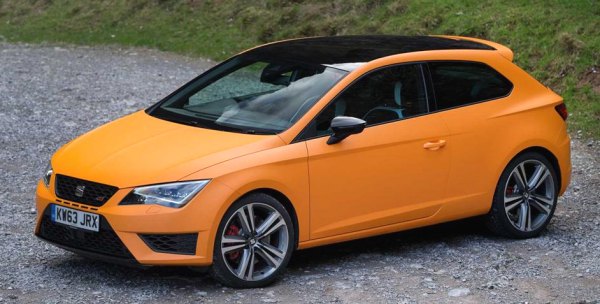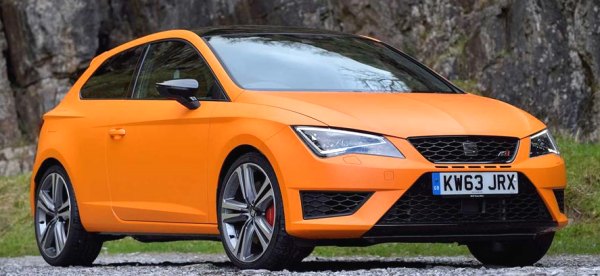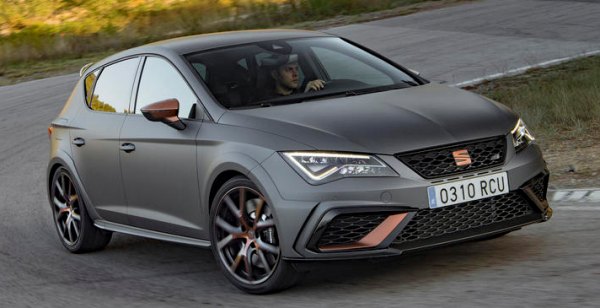Published
on 15
Nov 2012
|
All rights reserved.
|
|
|
People usually see
Seat Leon as a cheaper alternative to Volkswagen Golf and Audi A3.
While its underpinning platform and powertrains are practically the
same as the latter two's, its less elegant packaging and the lack of a
premium brand image mean you can buy a Leon at 10-15 percent lower
price than the equivalent VW or Audi. That sounds great value for
money! Besides, the Leon usually looks more stylish and drives sportier
than its siblings, so it could be the best buy to keen drivers.
We said the same things to the Mk1 (2000) and Mk2 (2005) Leon. Somehow,
their sales did not really take off, usually resting on the level of
100,000 units a year. The reasons could be complicated, but I suppose
one of which is that the Leon usually gave us an impression that it
deliberately downgraded the build quality (especially interior) to
avoid internal competition with Golf and A3. That decision might be
sensible for the interest of the whole group, but unfortunately Skoda
Octavia was not given the same downgrade. As a result, the Skoda
prospered at the expense of Seat. Yes, Leon has an edge in driver
appeal, but sandwiching between the VW/Audi and Skoda its survival
space is rather narrow, and this reflected in its sales results.
However, I think the new Leon Mk3 will have an easier life. This car no
longer tries to avoid direct competition with its siblings by going to
the extremes. It looks much more middle-of-the-road. Outside, the
boxier, edgier design is more conservative than the Mk2's organic
shape. In fact, it has some traces of the last generation Kia Cee'd, no
wonder Ferdinand Piech recently said his biggest regret was letting
Peter Schreyer left for Kia. Never mind, the fact that the new Leon
doesn't look adventurous is unlikely to have any negative impacts to
its sales. On the contrary, it might attract more average family
buyers, especially when the exterior build quality and detailing are as
good as Volkswagen's. It even offers a classy feature not
available to Golf as well as any other class rivals: LED headlamps.
Seat said this very expensive option has benefits like energy saving,
sleek design and a color
temperature more comfortable to eyes. However, the most important is
probably the message brought
these LED headlamps: Leon is no longer afraid of
competing with Golf!
The interior design sees the same confidence. As usual, it is simpler
and more driver-oriented than Golf. Ergonomics is even better thanks to
a high-mounted infotainment screen and slim A-pillars. Materials and
build quality are vastly improved to the extent that now it can face
any rivals other than the Golf and A3 – which have elevated to another
level again. Soft plastics cover the majority of surfaces that you are
most likely to touch. Adequate metallic and lacquered accents keep it
free of a dull impression. Most switch gears operate with satisfying
feel. Moreover, the 5.8-inch touchscreen is standard across the range.
Compare with its pricier siblings, it does give away an engine start
button, electronic parking brake and some classy materials. As a
result, it feels well-made rather than luxury.
The Mk3 is shorter than Mk2, but its wheelbase has been stretched from
2578 to 2636 mm like Golf. This frees up its interior space and benefit
especially rear passengers. The boxier profile also eases headroom at
the rear. Meanwhile, the boot is enlarged by 40 liters to 380
liters, a remarkable figure for its class. Despite of this, the new
Volkswagen MQB platform guarantees lighter weight thanks to the use of
more high strength, ultra-high strength and hot-formed steel. The
monocoque gains 15 percent stiffness yet weighs 25 kg less than
before. In addition to other weight saving parts, such as lighter
rear seat, airbags, engines, running gears and rear suspension, the new
Leon is an average 90 kg lighter than the car it replaces. Take the 140
hp 1.4TSI model for example, it tips the scale at only 1156 kilograms,
209 and 177 kg lighter than the comparable Alfa Giulietta and Ford
Focus respectively! It also undercuts the equivalent Golf by 57 kg. The
MQB improves weight distribution by tilting its engine 12 degrees
to the rear and shifting the front axle forward by 40 mm.
Like Golf, the new Leon has multi-link rear suspension reserved for
only the most powerful models, while cooking models has turned to
torsion-beam setup to save costs. The borderline is different though:
on the Golf engines with more than 120 hp are served with the
sophisticated rear suspension, whereas the Leon needs more than 150 hp.
This
mean both the big selling 140 hp 1.4TSI and 150 hp 2.0TDI employ the
cheaper suspension. In the real world, however, these cars still drive
better than the old one. You will find good body control and grip
contributed by the wider tracks, lighter weight and better chassis
balance, while the stiffer chassis and improved NVH result in a more
polished ride. Only on really poor surfaces you will realize the rear
suspension is non-independent, and the noise insulation is thinner than
the most refined cars in the class. The new electric power steering is
direct and nicely weighted. The 140 hp 1.4TSI engine offers plenty of smooth power
and flexibility, whereas the 6-speed manual gearbox has a slick
gearchange.
Overall, the car feels agile and fun to
drive, if not the most comfortable.
If the cooking models are good, the FR models – Seat's warm hatches –
are even better. You can choose between a 1.8 TSI EA888 engine with 180
horsepower and a high-output version of 2.0 TDI which produces 184 hp
and 280 lbft of torque. Both top at least 140 mph and sprint from 0 to
60 mph in 7.1 seconds. The diesel is especially impressive as it offers
very strong mid-range punch. It is also more eager to rev than the
usual diesel engines, with a power band not lasting until 4000 rpm,
although you need at least 1750 rpm to keep it on boost. The FR models
not only features multi-link suspension but also stiffer and 15 mm
lower suspension setup to deliver a firm yet well-damped ride. Their
standard-fitted "Seat Drive Profile" control system gives you the
choice of Eco, Normal and Sport mode to alter the characteristics of
throttle, steering and exhaust noise – the latter is
artificially produced by the speakers. The FR 2.0TDI is probably the
best driving diesel warm hatch to date, better than the outgoing
Golf GTD.
More impressive, the good performance and driving fun does not
compromise its green credential. For example, the 1.4 TSI returns 54
mpg and emits only 119 grams of CO2 per
km, which is superb for a gasoline model with such a brisk performance.
The FR diesel is even more incredible with 66 mpg and 112 g/km. These
figures must thanks to the MQB's lightweight construction, auto
stop-start and brake energy regeneration.
Overall, the new Leon is a strong contender in the C-segment. It is not
as classy or refined as the Golf VII, but it is a bit
more fun to drive and considerably cheaper to buy. From
enthusiast's point of view, I just hope it looks more adventurous and
technically more distinguished from its siblings. Besides, equipping
more models with multi-link suspension would be a good idea if it wants
to beat the dynamically accomplished Alfa Romeo Giulietta and Ford
Focus.
|
Verdict:     |
| Published
on 18
Mar
2013 |
All rights reserved.
|
|
Leon SC
|
|

|
The Leon SC (Sports Coupe)
tries to play the same tricks as Volkswagen Scirocco, i.e. to be
perceived as a hatchback coupe rather than the 3-door version of Leon.
However, the surgery it took was far milder. It is marginally shorter,
wider and lower than the 5-door. Its wheelbase is shortened by 35 mm.
Its rear screen is set 19 degrees faster. But these differences are too
subtle to be noticed. SEAT should have differed it with more radical
styling features, but it decided to stay understated, even more so than
Volkswagen! I am puzzling whether the Latin brand has been Germanized.
As expected, the dashboard is 100 percent identical to the 5-door's,
even
up to trims. The rear seats lose a little bit legroom but it can still
accommodate a couple of adults at ease. It does sacrifice the
convenience of accessing rear seats. This would have been easily
acceptable if the SC offered sportier handling and higher performance.
Unfortunately, the suspension setting and engine range are unchanged at
all. You can opt
for the FR models (with either 184hp 2.0TDI or 180 hp 1.8TSI engine) to
get firmer suspension, but so is the case of the 5-door. The loss of
rear doors saves only 20 kilograms, so performance is practically the
same.
Objectively speaking, the Leon SC is remarkably well rounded. It offers
a good bland of performance, handling, ride, refinement and economy,
while undercutting the equivalent Golf and A3 by considering margin.
However, the same can be said to the more practical 5-door Leon. The SC
just lacks some Latin emotions to distinguish itself from its sibling.
Now it's time to call back Giugiaro.
|
Verdict:    |
Published
on 16
Feb 2014
|
All rights reserved.
|
|
Leon Cupra
|
|

|
Among the four hot hatches
of Volkswagen group, i.e. Golf GTI, Audi S3, Seat Leon Cupra and Skoda
Octavia RS, the Spanish car is the most sensible to purchase. All share
the same underpinnings and up-to-date mechanicals, but the Leon Cupra
returns the highest performance per euro. It costs 10 percent less than
an equivalent Golf GTI yet offers 50 more horsepower and cuts half a
second from 0-60 mph sprint. Yes, it does lose the Volkswagen or Audi's
high-quality cabin and higher level of refinement, but in return you
get a less boring exterior design and a very stylish set of 18 or
19-inch alloy wheels.
The new Cupra is available in both 5-door hatchback body and
short-wheelbase, 3-door SC body. Its power comes from the familiar
EA888 2.0 TFSI engine with dual-injection (direct and port injection),
dual-variable cam phasing and variable exhaust valve lift. It has 2
states of tune: the standard Cupra produces 265 hp and 258 lbft like
the last generation car, while Cupra 280 produces 280 hp and the same
torque. This strategy is very much like Golf GTI and GTI Performance,
just being even more powerful. Equipped with DSG gearbox, the
high-power version is capable to top a regulated 155 mph and hit 60 mph
from standstill in 5.4 seconds. Manual gearbox adds a tenth, and the
slightly heavier 5-door adds another tenth. While it is nowhere as fast
as Mercedes A45 AMG or BMW M135i, among the affordable
front-wheel-drive hot hatches it is unbeatable.
 |
Benefited by the lightweight MQB platform, the new Cupra is 55 kg
lighter than the old car. It also gets a lot more sophisticated weapons
to improve driving dynamics, such as DCC adaptive damping, variable
ratio electrical power steering, an integrated dynamic control system
("Cupra Drive Profile") and, most important, the very same Haldex
electronic-controlled multi-plate clutch active LSD as on Golf GTI
Performance – and this is fitted as standard on both 265 hp and 280 hp
models! The 280 hp additionally gets 19-inch wheels, wider rubbers and
larger Brembo brakes to enhance sporting appeal.
On the road, the EA888 engine has a smooth and linear power delivery.
Turbo lag is more subtle than, say, Opel Astra OPC, which is to say
Volkswagen group makes a better engine than most rivals. In normal
driving it doesn't feel much different from the Golf GTI engine, but
when you rev it beyond 4500 rpm its extra punch is obvious. No, it is
never as frantic as an AMG M133 (i.e. A45 engine) on full song, nor its
exhaust note is as delicious to listen as Renaultsport Megane. It just
delivers its power efficiently to the front wheels without making you
notice. An unsung hero.
The 6-speed manual gearbox is a joy to use, thanks to its light and
accurate gearshifts. The DSG is faultless, but it doesn't bring the
same driving satisfaction as a good manual.

|
Even though 280 horsepower sounds a lot for a front-wheel-drive car,
the active LSD puts down the power cleanly. It generates bags of
front-end grip so that the nose obeys strictly your command, at least
on dry surfaces. Furthermore, there is little torque steer to speak of.
The steering wheel occasionally tugs a little bit under power in tight
corner, but it is very subtle and never threatens your control. This
friendly manner is also found on the superb ride quality. The
suspension setup is not too hardcore. Comfort and Sport modes bring a
compliant ride that is suitable on all kinds of road. Even the stiffest
"Cupra" mode is useable on smooth roads, not just racing tracks.
On the flip side, some keen drivers might regard it lacking a sporting
edge. Take the steering for example, while it is accurate, adequately
geared and weighted, it doesn't offer a strong sense of connection to
the road as Renaultsport Megane. The handling is not as responsive,
too. Unlike a mechanical limited slip differential, the active LSD
takes a short but noticeable moment to react. This mean when you push
it out of corner, the Cupra understeers first before it realizes the
problem and assigns more power to the outer front wheel. If you trust
it and keep pushing, it will ultimately tighten its line and storm
through the corner, though this delay is unpleasant to keen drivers.
Another weakness is the lack of throttle adjustability (like all
Volkswagen group hot hatches). Back off mid-corner will not push the
tail outward like Megane RS or Focus ST. As a result, it is not as
entertaining to drive as those cars.
Overall, the Leon Cupra is a practical yet highly capable hot hatch, if
not the most exciting to drive. A bit more wildness will be welcomed.
Will that be accomplished by the forthcoming Cupra R? We shall see.
|
Verdict:     |
Published
on 29
Nov 2017
|
All rights reserved.
|
|
Leon Cupra R
|
|

|
|
3
percent more power for a price jump of 75 percent. Not even a hot badge
and limited availability could justify that.
|
|
What badge sits above
Cupra as the hottest performance label of Seat? Cupra R, of course. To
that end, the first generation Leon Cupra R of 15 years ago introduced
an engine entirely different from its lesser sibling, i.e. a 1.8-liter
turbo instead of VR6. The second generation turned to a common 2-liter
turbocharged engine, but the Cupra R was tuned to produce 10 percent
more power and 17 percent more torque than the Cupra. What about the
latest Cupra R? Disappointingly, only 3 percent more power and, worse
still, zero percent more torque from the same EA888 2-liter turbo
motor. The latter comes straight from VW Golf GTi Clubsport S and the
latest Golf R, offering 310 horsepower and 280 pound-foot of torque.
Meanwhile, the car gains 58 kilograms over its lesser sibling, no
wonder its official 0-60 mph time stays the same at 5.5 seconds. FYR,
the Golf R takes 4.9 seconds thanks to its 4-wheel-drive system. Ford
Focus RS and Honda Civic Type R are both faster yet cheaper.
Yes, the new Leon Cupra R is too expensive. At £35K in the UK or
€45K in its home market, it is up to a whopping 75 percent dearer than
the Cupra! So what does this extra cash bring? Outside, there are some
cosmetic enhancements such as bronze finish on wheels, mirrors and
front intake blades, a few carbon-fiber aero kits (rear spoiler, front
splitter and diffuser) and reshaped exhausts. You may also notice the
wheel arch extensions that widen its front and rear track by 20mm. The
front suspension is retuned with increased negative camber. The
adaptive dampers are recalibrated as well. Power still goes through the
electronic-controlled LSD as in the case of the 300hp Cupra, but there
are now
retuned steering and larger front brakes (370mm discs) with 4-pot
Brembo calipers. Most important, you can now opt for Michelin Cup 2
tires as in the case of the Nurburgring-record-breaking Golf GTi
Clubsport S. Inside, there are bronze accents to match the exterior,
sportier bucket seats and Alcantara trims on steering wheel and
gearstick. If these sound not enough to justify the price jump, Seat
will tell you that it is limiting its production to only 799 cars.
Obviously, it knows the limited appeal of the car.
How does it feel on the road? Despite the numbers, the engine does feel
more energetic at the top end without losing the flexibility at lower
rpm. Meanwhile, its new exhaust produces a sportier noise, with
crackles on the overrun to give it more character. However, the most
significant difference lies on the chassis. It is not exactly
transformed, but it is clearly superior to the standard car. The
optional Cup 2 tires generate strong grip. The Brembo brakes are
powerful, although the pedal is too touchy at the top of travel. The
combination of stickier tires, more negative camber and a slightly
faster steering means the turn-in is sharper. The retuned dampers
deliver a stiffer ride but body roll and pitch are tightened. That
said, ultimately the Cupra R still lacks the overall competency of Golf
R. Neither can it match Focus RS or Civic Type R for driver engagement
and thrills. The fact that its rivals offer more for less is the most
worrying. Sometimes exclusivity helps to sell, but would you consider a
Seat as niche?
|
Verdict:     |
|